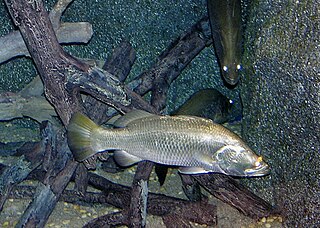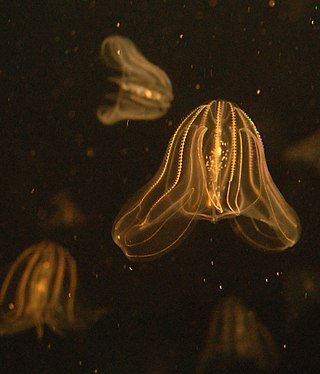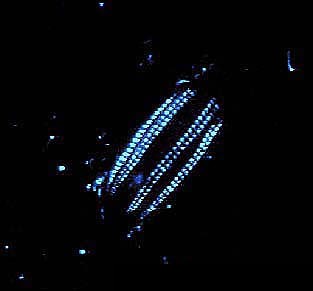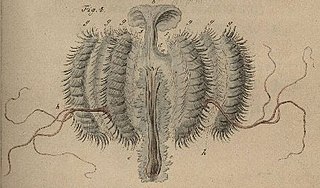
Carl Chun or Karl Friedrich Gustav Chun was a German marine biologist who worked as a professor at the University of Königsberg (1883), Breslau (1891) and at Leipzig (1898). He was a pioneer of German oceanographic research, organizing the first deep-sea expedition aboard the SS Valdivia in 1898-99. He spent much of his life studying the collections made during the expedition, and was responsible for discovering many marine organisms, including the vampire squid.

Lates is a genus of freshwater and euryhaline lates perches belonging to the family Latidae. The generic name is also used as a common name, lates, for many of the species.

Palaeoniscum is an extinct genus of ray-finned fish from the Permian period (Guadalupian-Lopingian) of England, Germany, Turkey, North America and Greenland, and possibly other regions. The genus was named Palaeoniscum in 1818 by Henri Marie Ducrotay de Blainville, but was later misspelled as Palaeoniscus by Blainville and other authors. Palaeoniscum belongs to the family Palaeoniscidae.

Nucula is a genus of very small saltwater clams. They are part of the family Nuculidae.

The Palaeonisciformes, commonly known as "palaeoniscoids" are an extinct grouping of primitive ray-finned fish (Actinopterygii), spanning from the Silurian/Devonian to the Cretaceous. They are generally considered paraphyletic, but their exact relationships to living ray-finned fish are uncertain. While some and perhaps most palaeoniscoids likely belong to the stem-group of Actinopteryii, it has been suggested that some may belong to the crown group, with some of these possibly related to Cladistia and/or Chondrostei. Many palaeoniscoids share a conservative body shape and a similar arrangement of skull bones, though paleoniscoids as a whole exhibit considerable diversity in body shape.

Amblypterus is an extinct genus of freshwater ray-finned fish that lived during the Gzhelian and Cisuralian epoch in what is now Europe and possibly India and Argentina. Potential indeterminate records stretch as far back as the early Carboniferous.

Palaeoniscidae is an extinct family of "palaeoniscoid" ray-finned fishes (Actinopterygii). The family includes the genus Palaeoniscum and potentially other Palaeozoic and Mesozoic early actinopterygian genera. The name is derived from the Ancient Greek words παλαιός and ὀνίσκος.

Pleurobrachia is a common genus of Ctenophora. Along with the genus Hormiphora, it generally has the common name sea gooseberry. It contains the following species:

Bolinopsidae is a family of ctenophores.
Cryptolobatidae is a family of ctenophores. It is the only family in the monotypic order Cryptolobiferida and contains two genera, each with a single species.

Karl Heinrich Mertens, was a German botanist and naturalist, and son of the botanist Franz Carl Mertens.

The Abylidae are a family of marine invertebrates in the order Siphonophorae. They are colonial, but the colonies can superficially resemble jellyfish; although they appear to be a single organism, each specimen is actually a colony of Siphonophora.

Colasposoma is a genus of leaf beetles in the subfamily Eumolpinae. It is known from Africa, Asia and Australia.

Beroe, commonly known as the cigar comb jellies, is a genus of comb jellies in the family Beroidae. Beroe exhibits bioluminescence.

Bolinopsis is a genus of ctenophores belonging to the family Bolinopsidae.

Euplokamis is a genus of ctenophores, or comb jellies, belonging to the monotypic family Euplokamididae. It shares the common name sea gooseberry with species of the genus Pleurobrachia. After being originally described by Chun (1879), the family Euplokamididae was expanded by Mills (1987) due to the discovery of a new species, Euplokamis dunlapae. Further research indicated that Euplokamis should be identified from Mertensiidae due to the rows of combs and some compression. They may also be distinguished from the genus Pleurobrachia due to their more elongated shape. Additionally, various adaptations of Euplokamis have been observed such as the use of tentacles for movement/feeding, a complex nervous system, and bioluminescent capabilities. Other characteristics including a defined mesoderm, lack of stinging cells, developmental differences, and symmetry supported the reclassification of these organisms.

Callianira is a genus of ctenophores belonging to the family Mertensiidae.
Lampea is a genus of ctenophores belonging to the family Lampeidae.
Cydippidae is a family of ctenophores, in the Cydippida.
















